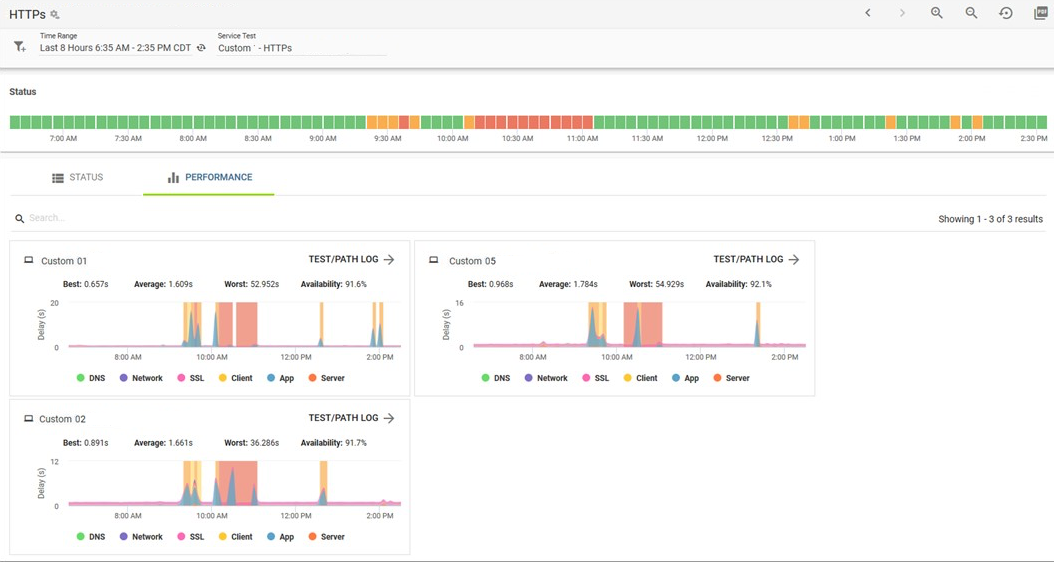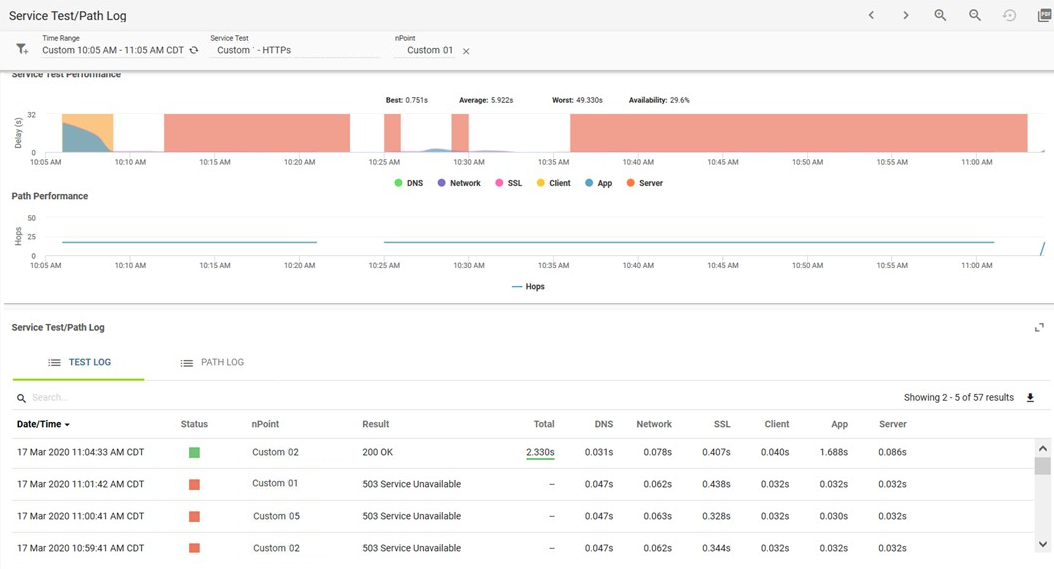
Highlights
- Usage of Telemedicine service quadrupled in 2 weeks
- Needed visibility into potential performance and capacity issues
- nGeniusONE® Service Assurance platform and InfiniStreamNG® appliances
- nGeniusPULSE and nPoints
- Quickly identified potential capacity issue before widespread patient impact
- Maintain high quality experience patients expect
Overview
The use of telehealth services to connect patients with doctors over live video has been on the increase for the last several years, as it provides greater access to affordable, high-quality care without an in-person visit. Fueled by significant improvements in digital technology, the use and adoption of telehealth services have been on the rise in response to the need for healthcare support in rural communities and access to medical specialists. Due to the criticality of video quality for accurate diagnosis and clarity of voice for communicating conclusions and instructions, IT organizations often take steps to ensure visibility into the performance of these telehealth services.
Hospitals and healthcare clinics with well-established telehealth systems were well-prepared to provide a safe alternative for their patients needing access to medical care while following government orders for social distancing to reduce exposure to the recent outbreak of the Coronavirus (COVID-19). When one such hospital saw use of their telehealth service increasing, they took action to ensure quality end user experience was maintained for patients, families and medical personnel required additional visibility.
Performance Issue
For telehealth services to be effective and accepted, a flawless experience must be provided for both participants - the patient, as well as the healthcare professional. Dropped calls, inability to access or log‑in to the application, or choppy voice or video are examples of issues to be avoided. Recently, when COVID-19 drove government orders for social distancing, school closures, and work from home directives, one particular hospital saw use and volume of its telemedicine application quadruple over a two-week period. Gaining access to the application, with the dramatic change in demand, became an issue for some patients.
Impact
The most obvious impact of this unavailability was that patients wanting to set a telemedicine appointment couldn’t get through. Patients trying to participate in a scheduled appointment were either delayed, or worse, completely unable to gain access for that session. Either of these situations can lead to delays in treatment or forces a patient to settle for an in-person appointment that may challenging to get to or put them at risk for other illnesses. An additional casualty of unavailability to this critical application can be the hospital’s reputation for patient-care service and prompt treatment. It is easy to see why early detection and rapid triage to diagnose the root cause of telehealth service unavailability is so critical.
Troubleshooting
In this case, a two-part strategy was employed to detect and triage an unavailability problem with the telemedicine service. First, using NETSCOUT® nGenius®PULSE with a few strategically deployed nPoints on the hospital campus configured to perform scheduled HTTP tests on the website page (URL) for their telehealth application service, the IT team and NETSCOUT Remote Site Engineer (RSE) quickly saw the early stages of the unavailability in the dashboard (Figure 1).
Green, yellow, and red indicators show the range of availability, or lack thereof, over the 8-hour period selected. The Status view revealed that an issue briefly appeared around 9:35am and worsened between 10:15 a.m. and 11:05 a.m. The details from the individual nPoints performing the test are also available in the dashboard screen and clearly show server issues. The team investigated further and views into the HTTP tests from the first nPoint reported several “503 Service Unavailable” errors (Figure 2). The team knew this was an issue that needed immediate attention.

Figure 1: Dashboard View of nGeniusPULSE, with three nPoints performing HTTP tests focused on their telemedicine application website their telemedicine application website shows unavailability between 10 am and 11:30 am.
Recognizing that the “503 Service Unavailable” error pointed to an issue with the website for telehealth service, they needed clarity on what was the actual source of the issue with the Web service. The hospital’s IT team and RSE turned to the installed NETSCOUT nGeniusONE® Service Assurance platform and leveraged dashboard views for the telehealth application that confirmed bandwidth saturation coming into the website. Further analysis using nGeniusONE service dependency map views for the telehealth service revealed that the service itself did not have an issue; however, it simply was unable to support the exponential increase in volume, and the hospital required additional server capacity to support the greater demand.

Figure 2: View of the HTTP Service Test performed by one of the nPoints on the Telemedicine website revealed 503 Service Unavailable Errors.
Remediation
nGeniusPULSE pointed to an issue in availability for the hospital’s telehealth website early in the incident. And nGeniusONE helped isolate the issue to server capacity. The IT team at the hospital was able to rapidly coordinate with appropriate vendor partners to add several additional servers to handle what has become the new normal for the adoption and use of the application.
Summary
There is no doubt virtual appointments represent a viable, responsible and expanding solution to handling common, less-serious health issues. Likewise, the quality of voice and video experience over smart phones, tablets, and computers is undoubtedly essential to their success and continued growth. This use case has demonstrated how quickly nGeniusPULSE with HTTP nPoint tests can discover availability issues in their early stages, which will reduce lengthy delays in access for patients in need of healthcare services. nGeniusONE saved the IT staff time in pinpointing where in the path of this website ecosystem additional capacity was required so they could put corrective plans in action as quickly as possible.
NETSCOUT’s nGeniusONE Service Assurance Solution and nGeniusPULSE help IT staffs in hospitals and providers assure service availability, swift connections, and high-quality voice and video.



